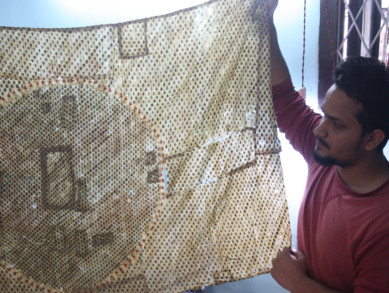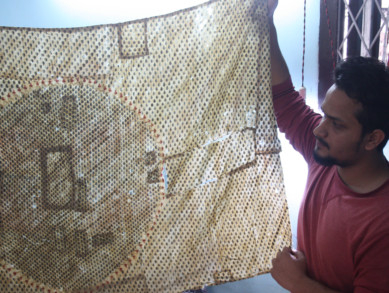_resources1_16a4505465b_medium.jpg)
NEW DELHI: They can be called the healing agents, who weave poetry and metaphors into fabrics that would not have survived without their intervention.
The rafoogars (menders) use the humble needle and thread to efface a flaw in a way that renders it non-existent.
It’s an art that was once much sought after as people who valued their heirloom shawl or a precious new garment looked for reparation.
“By its nature, rafoogari or the art of repair should be of such finesse that it is not visible at all. The more it remains hidden, the more the proof of its excellence,” says Intekhab Ahmad, the 46-year-old fourth generation rafoogar from Najibabad town, about 200km from Delhi, the Indian capital.
Once considered the hub of darning, Najibabad has only a few families left who maintain the tradition.
The power of needle and thread
“Handicrafts are not just about decoration. For us, making them is a means of livelihood,” Ahmed told Gulf News.
“For most people, a strand of thread may not be of much significance, but it has a resilience that is invaluable. It possesses the ability to hold together a textile that is torn or frayed. It is through this thread that a cloth’s lifetime is prolonged by way of rafoogari.”
60 %
of a 300-yearold shawl was destroyed by bugsPointing to a shawl he is mending, the fourth generation artisan says: “This is over 200 years old and was given to me for darning by a wealthy family from Rajasthan. Its restoration work comprises two methods — patchwork and tana-bana (interlay).
_resources1_16a45054663_original-ratio.jpg)
"In the patchwork style of darning, a part of the same cloth is cut and fixed over the torn part with fine stitches. Whereas, in tana-bana, threads from the cloth are pulled out from a portion away from the tear and intricate cross-stitching undertaken that must have the finesse to appear invisible. The flaw must be rendered virtually imperceptible.”

Numerous items of clothing, including Hyderabadi shawls with intricate designs to hand-stitched men’s long-sleeved pashmina cloak in Mughal style, have been restored by rafoogari.
‘My grandfather’s shawl’
Ahmed’s interest in the craft was a natural extension of his ancestral roots. He began assisting his father and grandfather at the age of six. “After returning from school, I used to work with them and on completing graduation, joined the family enterprise full-time,” he says.
Proud of his lineage, Ahmed flaunts a 300-year-old jamawar shawl that belonged to his grandfather. “I discovered it a decade ago when almost 60 per cent of its design, referred to as makkhi buti (fly motif), was destroyed by bugs. It had been lying in disuse for years, its condition absolutely pathetic. My grandfather wore it at family functions. I decided to repair it. Mending it alongside other works, I restored the treasured shawl to its lost glory in six years,” he says.
A fading skill
The centuries-old rafoogari art is now on the decline and barely a dozen experts from Najibabad, including Mohammad Shariq, Mohammad Tabish, Mohammad Zakir, Shahadat Ali, Zafar Islam, Rashid Khan, Mohammad Ikrar and Shariq Khan, hold the potent power of this craft that continues to embody the histories of fabrics. Some among them are engrossed in their work sitting cross-legged on mattresses in an empty room. The dingy locale is in south Delhi’s Khirkee Extension area in Malviya Nagar, opposite Select City Mall, Saket.

The group routinely comes to the city every October and on completion of orders here, either returns to their hometown or travels to other states including Rajasthan, Maharashtra and Madhya Pradesh, for work.
Even the snooker table baize gets a makeover
Repairing the baize on a snooker table Shariq, a third-generation craftsman, is probably the only rafoogar in the country having expertise in mending baize (coarse green colour woollen cloth used on snooker tables).
3 rd
generation artist Shariq also mends snooker table baize“I learnt it on my own,” he said proudly. Shariq had mended a jamawar shawl of a celebrity client, who introduced him to a friend, managing a sports club. “I laughed when he asked if I could mend the snooker table cover. When he insisted in all seriousness, I was puzzled how a coarse fabric could be repaired without removing it off the table,” he said.
But days of labour proved successful and Shariq showed his rafoogari skills by doing an excellent job. “Thereafter, I got more such offers and was requested to show my magic on expensive sofa upholstery and car seats,” he laughs.
Patience and a straight back
It could take at least two years to learn and get used to the rafoogari skills.
As with several other art forms, the younger generation is not keen on it, perhaps because though it requires immense patience and precision, monetarily, rafoogari is not lucrative.
Even connoisseurs of fine clothing who flaunt their age-old collection in society, seldom acknowledge that the garment was damaged, but painstakingly restored by a rafoogar. ‘It’s therefore not surprising that interest in the art has waned,’ Mohammad Tabish says
Rafoogari is a challenge that requires sitting on the floor endlessly through the day while maintaining an upright back. "One needs to have a passion for it else the result can be shoddy," he says.
"Tabish has heard that over time, a craftsman’s eyesight becomes weak. Unconcerned about that aspect, he is focused only on the art’s lineage. ‘Just as we heal our body, adding years to our life, a true rafoogar’s job is to use the darning techniques to make the garment wearable, without letting it lose its sheen.’














